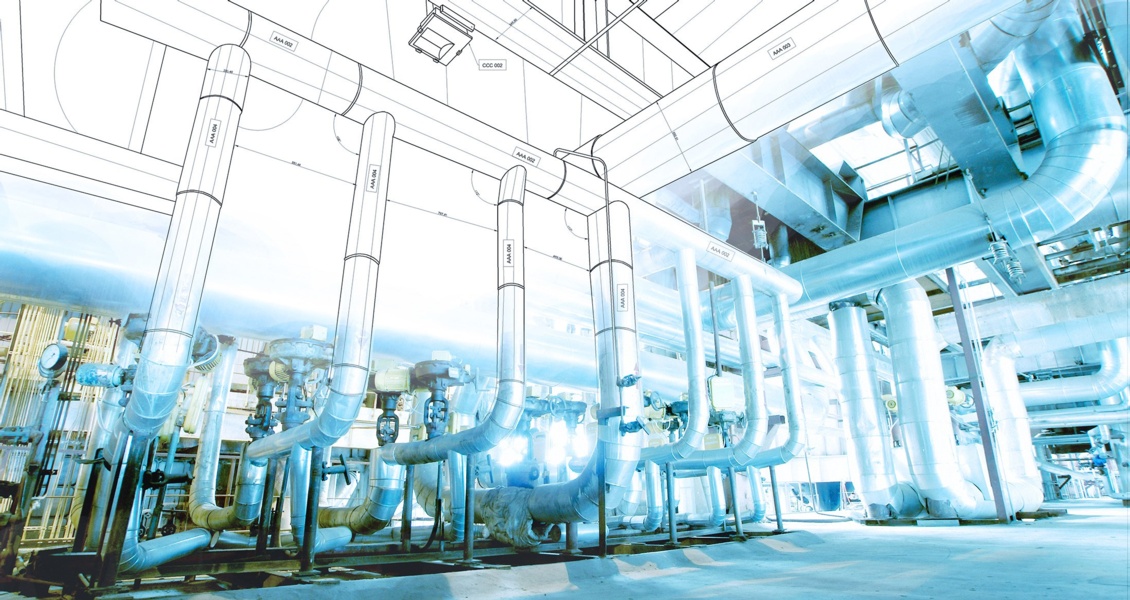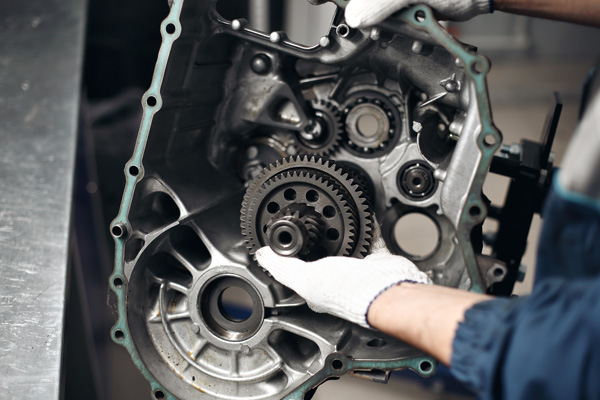In this article, we will explore how maintenance, repair and operations/overhaul (MRO) can benefit from digital transformation, including:
- Why you should digitize your MRO and enterprise asset management (EAM) practices
- How digitizing these areas of your business can create value within your existing infrastructure
- What types of software can jumpstart this digital transformation in your organization

Managing the complexities of MRO is nothing short of challenging. There are maintenance technicians to direct, labor to allocate, assets to keep track of, spare parts inventory to worry about and supplier networks to maintain. And when equipment breaks down unexpectedly, your manufacturing operation can be hemorrhaging money by the second.
Add on top of this pressures from increasingly squeezed supply chains, labor and technician shortages, and a growing trend of bringing MRO operations in-house, and it’s understandable why many MRO professionals feel a bit cornered.
Technology may be changing that.
In decades past, MRO has been treated as a necessary but inevitable expense—that is, an afterthought. Executives would only pay attention to MRO when something went wrong. Fortunately, businesses are beginning to realize that this background process is critical to organizational health. The modern philosophy believes you should treat MRO spend as an investment in your operation’s future reliability and uptime.
In a 2018 survey conducted by Peerless Research Group (PRG), 94% of companies now “view MRO as an important part of their overall operations.” Of those surveyed, 22% are already spending more on MRO than they did a few years ago.
However, if you are like the other 78%, introducing automation technologies with a short ROI may be a way for your operation to drive improvement without increasing your annual spend. Digitizing technology is already making waves in MRO across the globe.
Maximizing Uptime Through MRO Digitization
For manufacturers, it all comes down to the bottom line: If your machines are down, you’re not making product and you’re not making money.
Many companies are still handling MRO the traditional way, using pen and paper, clipboards, spreadsheets or even fixed workstations. These practices don’t support the ability to deliver predictive maintenance and can only take your operation so far in terms of reducing downtime, managing maintenance, assets and spare parts.
Digital transformation is the process of introducing technology to digitize and automate manual business processes to minimize unplanned maintenance, maximize uptime and profitability. Digitization holds the potential to unlock new levels of efficiency, productivity, and reliability while simultaneously reducing costs and overhead.
Next, we’re going to break down how maintenance and enterprise asset management technologies (MEAM) can simplify and accelerate processes in three segments of MRO: maintenance work orders, assets tracking and spare parts inventory.
M is for Maintenance
The “M” in MEAM stands for maintenance management, a mission-critical component of manufacturing uptime.
Maintenance traditionally involves Preventive Maintenance and Corrective Maintenance, typically handled through a system of work orders (WO). Once a WO is created, a maintenance technician takes the assigned tools, spare parts, and consumables designated on the WO and goes to inspect or fix the machine.
In Preventive Maintenance, regularly scheduled or planned maintenance is designed to keep machinery in top working order to minimize unplanned downtime. While preventative measures do help reduce downtime, maintenance techs don’t always detect issues as or before they arise. If spare parts aren’t available to carry out the assigned tasks, then planned maintenance has the potential to turn into unplanned maintenance in the near future.
In Corrective Maintenance, machinery and equipment are repaired after a breakdown. Since unplanned maintenance isn’t planned—and may even constitute an emergency—there is no way to know if, when, or where this will happen. An emergency stoppage can bring the production line to a grinding halt. If required parts aren’t unhanded or have become obsolete, that stoppage time can be drawn out by hours, days, or even weeks.
How Technology Helps Maintenance & Work Order Management (WOM)
Technologies have since emerged that not only make plant maintenance more efficient but also enable the ability to perform Predictive Maintenance. In Predictive Maintenance, data gathered from monitoring equipment performance allows management to identify trends, and thereby are able to predict when machines will be likely to fail or break.
If you are using an enterprise resource planning (ERP) platform, maintenance data can be integrated with your other business data to gather a more holistic view of the overall operation. Specialized Maintenance Modules, such as SAP Plant Maintenance (PM), enhance your ability to track equipment, maintenance procedures and similar tasks.
Other specialized maintenance management software, sometimes referred to as Computerized Maintenance Management Systems (CMMS), offer similar digitized functionality, but with a narrower focus.
While software like ERPs and CMMS solutions help management run a more efficient business, digital transformation can also be extended to the maintenance technicians as well. For example, most operations need a mobile work order management solution that techs can take and use in the field and on-site.
Instead of hunting down paperwork, reference materials, tools, and parts by hand, a software tool like RFgen allow the technician to handle every stage of the work order process directly from a mobile device, such as a tablet, including the check-in/checkout of tools, assets, and consumption of spare parts. Not only is the RFgen app simple, easy to use, and intuitive, but it also uses a mobile platform that communicates bi-directionally with ERPs and other critical business technologies in real-time or by using off-network High Availability.
In summary, digitizing maintenance and work order management processes can help your organization:
- Increase worker productivity by providing up-to-date work order queues
- Prioritize work orders based on urgency and available assets/spare parts
- Unify business data by linking WO information with your ERP system
EAM: The Challenge of Tracking Assets
Enterprise asset management (EAM) is the second segment of MRO where technology offers benefits.
Assets are tangible inventory items that must be inspected, maintained, and are tracked with performance metrics. In MRO, these are usually fixed assets of some kind that fall under the classification of property, plant and equipment (PP&E). PP&E assets include tools, equipment, and machinery used for maintaining regular operations but are not sold as an end-product.
Perhaps the biggest challenge facing the asset management is, “Where are my assets?”
At the enterprise level, you probably use large quantities of assets spread across dozens (if not hundreds) of locations. For these asset-intensive organizations, some kind of EAM strategy is necessary to manage and streamline performance, effort, resources, and time investment related to those assets.
How Technology Improves EAM Methodologies
Technology, such as asset tracking software, combined with barcoding and ERP system can support an effective EAM strategy by solving asset-related MRO challenges:
- Increasing visibility of available assets across the enterprise
- Reducing the need for storing excess depreciating assets
- Minimizing work order backlogs and downtime due to missing assets
Combined with mobile work order management software, your workers will always have an accurate picture of what assets are available for consumption and at what location, greatly optimizing the entire maintenance process. Meanwhile, management will be able to reduce expenses and overhead from depreciation and loss of production time.
Best-of-Breed EAM vs ERP-centric EAM
One of the common challenges IT professionals face when researching new EAM technology is whether to take on a standalone best-of-breed (BoB) solution or to extend their existing ERP platform with a specialized maintenance module.
When the first ERP maintenance modules hit the market, they tended to be somewhat crude and clunky, giving rise to the need for standalone best-of-breed EAM software. But over the years, the capabilities of plant maintenance modules for ERPs have steadily improved in functionality and sophistication to the point that now they provide most of the necessary functionality for businesses wanting to manage assets digitally.
This leaves IT, managers and executives, with a difficult choice between two paths to digitizing EAM: best-of-breed standalone software or ERP module? With ERPs gaining more prominence each year, maybe choosing an ERP-centric EAM solution is the way to go.
Let’s explore why that is:
Best-of-Breed Asset Management Software
Advantages: A best-of-breed EAM platform like IBM’s Maximo software provides a comprehensive, sophisticated asset management solution capable of handling workflows for maintenance, work orders, asset management, and much more.
Drawbacks: The largest challenge to taking on a standalone EAM technology—even if it is the best-of-breed on the market—is the fact that it isn’t connected to your financial systems, such as those in your ERP. When handling large amounts of MRO inventory and the spending associated with handling those materials, having financial data siloed in two systems can lead to countless problems.
Integrating standalone EAM software with your ERP can be complicated, costly, and time-intensive, requiring months or even years to accomplish. Even then, there is no guarantee that integration will succeed. A surprisingly large amount of technology implementations fail or only achieve marginal success.
ERP-based Asset Management Software
Advantages: This route involves expanding your existing ERP with additional functionality by means of a specialized bolt-on module that connects to your financial systems with relative ease. For example, Oracle’s JD Edwards provides a module specifically for plant and equipment maintenance management. SAP and other ERPs provide similar modules for their own systems. Not only are “bolt-on” modules easier to integrate, but they also offer shorter implementation periods, lower cost, fewer headaches, and a greater chance for a stable, successful implementation.
Drawbacks: While plant maintenance modules offer the EAM capabilities required by most organizations, larger enterprises still may have a need for best-of-breed software that goes the extra mile in terms of depth, reach and capability. Another disadvantage of ERP-centric EAM software (even specialized modules) is that ERPs tend to fall short when it comes to native mobility functionality.
EAM Mobility
Mobilizing your ERP data can drastically improve your digital asset tracking practices. A mobile solution like RFgen Mobile Unity Platform can extend your ERP data onto mobile or handheld devices through an ecosystem of hardware, software and zero-footprint integration.
For your workforce, a mobility solution can provide a user experience that is simple, focused, and purpose-built to solve the challenges inherent in their daily tasks, such as with mobile asset tracking or mobile maintenance work order software for technicians.
For your IT team, a mobility solution can fill the mobility gap left by your ERP so that you don’t have to pursue a separate best-of-breed EAM solution.
READ MORE: Embracing Mobility Essential in Maintenance, Field Service Operations »
The Materials Supply Chain (MRO Inventory)
MRO inventory consists of the spare parts and supplies used to service assets, such as plant facilities, equipment, tools, and heavy machinery. Having the parts needed to perform planned maintenance as well as extra stock for unplanned emergency maintenance are both fundamental to effectively managing a materials supply chain.
Even though MRO inventory plays a crucial role in the maintenance process, spare parts management and stock levels are often overlooked. Spare parts are the bread and butter components of conducting maintenance, so to ensure that enough parts available for any eventually, manufacturers tend to stock all possible spare parts at or near each site where the machinery operates.
While this may be a sound method for mitigating potential downtime on the production line, it also has the potential to tie up significant capital inexpensive inventory items that depreciate in value and viability over time—if they are ever used at all.
The only alternative may not help in terms of overhead. If management maintains fewer spare parts and an unplanned breakdown occurs, that may mean rushing the required part(s) via same-day or overnight delivery, which can cost thousands of dollars.
Either way, your operation loses money on the production line from stocking too little MRO inventory or loses money by stocking too many spare parts, many of which will never be needed.
The 2018 MRO survey by PRG mentioned previously indicated that 42% of respondents felt that inventory tracking for parts and consumables still needed improvement while 21% experienced difficulty in finding parts. 41% of MRO professionals indicated that MRO represented a substantial expense.
Dr. Klaus Blache from the University of Tennessee says that inventory costs associated with MRO can eat over 50% of a plant’s given maintenance budget.
Technology can drive improvements in all these areas.
How Technology Optimizes Materials Management in MRO
MRO inventory is one area where technology can make a big impact. For example, the right technology solution can not only alleviate the conundrum presented by both scenarios mentioned above but can also drive down carrying costs and profit loss due to missing parts.
Let’s look at a few digital solutions that can help improve MRO inventory, spare parts, and consumables management:
Mobile Data Collection: A combination of RFgen mobile software, automated data capture (ADC) using handheld scanners and barcodes eliminates manual data entry processes in receiving, driving very high levels of inventory accuracy that transact with your ERP in real-time.
Inventory Management: Digitizing your inventory system of record enables you to gain visibility into stock levels and materials as they flow through your warehouse, production floor, and work order system. Managers can hold lower stock levels, freeing up working capital and reducing overhead costs as parts are only replenished to levels necessary to run the business efficiently. You can also plan ahead for highly specialized parts that may take weeks to arrive.
The key to gaining the most efficient in this area is to approach MRO inventory with the same level of control and scrutiny as a true inventory management system, like the ones used on the production floor for materials management or an IMS used in a distribution facility.
Combining mobile data collection with inventory management makes for a powerful duo that can integrate and share data with your ERP and other business systems across the enterprise. Defense contractor VSE Corporation took the leap to digitally transform both parts of their business with transformative results.
WMS Software: A warehouse management system (WMS) can add even more functionality by offering directed work based on known inventory data for pick, pack, ship, and other internal warehouse workflows. For example, RFgen’s Warehouse Director provides employees with directed picking paths that optimize their routes as they make their way through the warehouse so they don’t waste time double backing to find binned items.
With one or more of these technologies working in your MRO operation, maintenance techs need never worry about facing an excessive backlog of WOs due to missing parts. Instead, inventory workers can anticipate the maintenance tech’s arrival and have the parts ready to go when the tech arrives. The new levels of visibility and available data also help support the implementation and tracking of MRO KPIs.
Bringing It All Together: Unifying Three Segments of MRO
While we’ve taken the time to discuss how digital transformation can improve maintenance work orders, enterprise asset management and MRO inventory processes, each of these three segments are interlinked in a holistic ecosystem. Digitizing all three areas with automation technology can provide your operation with numerous significant benefits, such as:
- Drastically higher efficiency, productivity, speed and accuracy.
- New levels of governance, oversight and data-driven decision-making.
- Real-time visibility on assets, tools, spare parts and consumables across the enterprise.
- Holistic unification of MEAM, materials, production, ERP and other business software systems.
- Risk mitigation, minimized unplanned downtime, maximized uptime.
- Lower operation costs, overhead, and depreciation of assets and spare parts.
- Greater workforce flexibility, mobility and job satisfaction.
Lastly, having an implementation strategy will be critical to successful digital transformation. Introducing any major technology inevitably alters existing workflows, impacting the processes employees use on a daily basis. And while this may be challenging to adjust to at first, increasing automation in critical functions will benefit your organization in the long run, positioning your business for future scalability and growth.
While cultural ideals and philosophies are shifting more and more toward digital transformation in MRO and manufacturing, it’s important to start planning a strategy sooner rather than later.
Already, too many organizations have fallen behind on their digital transformation initiatives. A study conducted by SAP and Oxford Economics revealed that only 3% of executives had rolled out digital transformation initiatives across their enterprise, even though 84% claimed that digital transformation is critical to their survival between now and 2022.
Five years from now, that 3% may find themselves on top of the competition in terms of profitability, efficiency, and market share.
If you are looking to find the right technology solution that offers a rapid ROI to help you squeeze the most efficient and cost savings out of your existing infrastructure, consider a mobile platform that supports or integrates with each of the MRO technologies discussed in this article. Mobilizing your workforce can extend the functionality of your centralized business systems by untethering employees from fixed workstations and increasing overall productivity, efficiency, and performance.
For example, this national transportation company automated and mobilized their rail operations, including plant maintenance and inventory control using the RFgen Mobile Data Collection Solution.
Also Read: Combating Manufacturing Supply Chain Pressures in 2020 »
Additional Resources:
While MRO in manufacturing served as the focus of this article, maintenance, repair and operations (or overhaul) is also vital to maintenance service providers, government contractors and enterprises that manage fleets of vehicles or aircraft. The role of technology in MRO has increased over the years and will continue to increase as the world digitizes.
Below you can find additional reading about specific MRO-heavy industries that can also benefit from MEAM automation and digital transformation:
- Aviation, Aerospace and Defense: Read about the importance of aircraft MRO
- Pharmaceuticals, Chemical and Food Manufacturing: Read about best practices for pharmaceutical MRO
- Energy, such as Public Utilities or Oil and Gas: Read about digital transformation at BP
- Automotive, Transportation and Railways: Read Deloitte’s strategies for smarter MRO
- Engineering & Construction: Read about building a world-class MRO program
Related Terms
ADC: Automated data capture, usually referring to mobile barcoding software that automates data collection through scans rather than traditional, error-prone data entry methods. Implementing mobile data collection with barcodes is a strong first step toward digital transformation and automation.
EAM vs APM: Understanding the difference between EAM and Asset Performance Management (APM), the system designed around performance and continuous improvement of assets.
MEAM: Maintenance + Enterprise Asset Management (or M+EAM) is a shorthand term to describe managing maintenance, assets, and MRO inventory as a holistic ecosystem through digitization, automation, and mobility.











